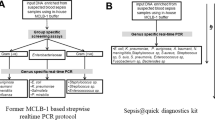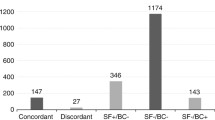Abstract
Bloodstream infections (BSIs) require an accurate and fast identification of causative pathogens. Molecular diagnostics, in particular polymerase chain reaction (PCR)-based approaches for BSI diagnostics directly from whole blood, suffer from limitations such as inhibition leading to invalid results. In this retrospective study, we analyzed 23 parameters for their potential interference with LightCycler SeptiFast PCR tests (n = 2167) routinely performed at our institution. The overall inhibition rate was 9.1%. Test date, type of ward, procalcitonin levels, high leukocyte counts, and absolute neutrophil count were significantly associated with inhibition. For a subset (n = 448), cut-off values for leukocyte counts of < 5700 cells/μL and ≥ 26,900 cells/μL were significantly associated with a low (5%) and high (67%) inhibition risk. For patients with a moderate to high leukocyte count (5700–26,900 cells/μL), the additional administration of hydrocortisone significantly increased the inhibition risk. Furthermore, freezing of blood samples prior to DNA extraction and SF testing appeared to neutralize inhibitory factors. It remains to be investigated whether other molecular diagnostic tests are susceptible to similar inhibiting parameters.


Similar content being viewed by others
Data availability
Data that is supporting our results is available in the electronic supplementary material. The complete data set for this study is available from the corresponding author [DOH] upon reasonable request.
References
Martin GS, Mannino DM, Eaton S, Moss M (2003) The epidemiology of Sepsis in the United States from 1979 through 2000. N Engl J Med 348:1546–1554. https://doi.org/10.1056/NEJMoa022139
Goto M, Al-Hasan MN (2013) Overall burden of bloodstream infection and nosocomial bloodstream infection in North America and Europe. Clin Microbiol Infect 19:501–509. https://doi.org/10.1128/JCM.39.2.485-493.2001691.12195
Kumar A, Roberts D, Wood KE, Light B, Parrillo JE, Sharma S et al (2006) Duration of hypotension before initiation of effective antimicrobial therapy is the critical determinant of survival in human septic shock. Crit Care Med 34:1589–1596. https://doi.org/10.1097/01.CCM.0000217961.75225.E9
Korber F, Zeller I, Grünstäudl M, Willinger B, Apfalter P, Hirschl AM et al (2017) SeptiFast versus blood culture in clinical routine – a report on 3 years experience. Wien Klin Wochenschr 129:427–434. https://doi.org/10.1007/s00508-017-1181-3
Lamy B, Dargère S, Arendrup MC, Parienti J-J, Tattevin P (2016) How to optimize the use of blood cultures for the diagnosis of bloodstream infections? A state-of-the art. Front Microbiol 7:697. https://doi.org/10.3389/fmicb.2016.00697
Fenollar F, Raoult D (2007) Molecular diagnosis of bloodstream infections caused by non-cultivable bacteria. Int J Antimicrob Agents 30:7–15. https://doi.org/10.1016/j.ijantimicag.2007.06.024
Lamas CC (2003) Blood culture negative endocarditis: analysis of 63 cases presenting over 25 years. Heart 89:258–262. https://doi.org/10.1136/heart.89.3.258
Stevenson M, Pandor A, Martyn-St James M, Rafia R, Uttley L, Stevens J, et al. (2016) Sepsis: the LightCycler SeptiFast Test MGRADE®, SepsiTest™ and IRIDICA BAC BSI assay for rapidly identifying bloodstream bacteria and fungi – a systematic review and economic evaluation Health Technol Assess (Rockv) 20:1–246. https://doi.org/10.3310/hta20460
Dark P, Blackwood B, Gates S, McAuley D, Perkins GD, McMullan R et al (2015) Accuracy of LightCycler® SeptiFast for the detection and identification of pathogens in the blood of patients with suspected sepsis: a systematic review and meta-analysis. Intensive Care Med 41:21–33. https://doi.org/10.1007/s00134-014-3553-8
Pilecky M, Schildberger A, Knabl L, Orth-Höller D, Weber V (2019) Influence of antibiotic treatment on the detection of S. aureus in whole blood following pathogen enrichment. BMC Microbiol 19:180. https://doi.org/10.1186/s12866-019-1559-7
Grif K, Fille M, Würzner R, Weiss G, Lorenz I, Gruber G et al (2012) Rapid detection of bloodstream pathogens by real-time PCR in patients with sepsis. Wien Klin Wochenschr 124:266–270. https://doi.org/10.1007/s00508-012-0159-4
Elges S, Arnold R, Liesenfeld O, Kofla G, Mikolajewska A, Schwartz S et al (2017) Prospective evaluation of the SeptiFAST multiplex real-time PCR assay for surveillance and diagnosis of infections in haematological patients after allogeneic stem cell transplantation compared to routine microbiological assays and an in-house real-time P. Mycoses 60:781–788. https://doi.org/10.1111/myc.12662
Ratzinger F, Tsirkinidou I, Haslacher H, Perkmann T, Schmetterer KG, Mitteregger D et al (2016) Evaluation of the SeptiFast MGRADE test on standard care wards—a cohort study. PLoS One 11:e0151108. https://doi.org/10.1371/journal.pone.0151108
van de Groep K, Bos MP, Savelkoul PHM, Rubenjan A, Gazenbeek C, Melchers WJG et al (2018) Development and first evaluation of a novel multiplex real-time PCR on whole blood samples for rapid pathogen identification in critically ill patients with sepsis. Eur J Clin Microbiol Infect Dis 37:1333–1344. https://doi.org/10.1007/s10096-018-3255-1
Opota O, Jaton K, Greub G (2015) Microbial diagnosis of bloodstream infection: towards molecular diagnosis directly from blood. Clin Microbiol Infect 21:323–331. https://doi.org/10.1016/j.cmi.2015.02.005
Schrader C, Schielke A, Ellerbroek L, Johne R (2012) PCR inhibitors - occurrence, properties and removal. J Appl Microbiol 113:1014–1026. https://doi.org/10.1111/j.1365-2672.2012.05384.x
Lehmann LE, Hunfeld K-P, Emrich T, Haberhausen G, Wissing H, Hoeft A et al (2008) A multiplex real-time PCR assay for rapid detection and differentiation of 25 bacterial and fungal pathogens from whole blood samples. Med Microbiol Immunol 197:313–324. https://doi.org/10.1007/s00430-007-0063-0
Makristathis A, Harrison N, Ratzinger F, Kussmann M, Selitsch B, Forstner C et al (2018) Substantial diagnostic impact of blood culture independent molecular methods in bloodstream infections: superior performance of PCR/ESI-MS. Sci Rep 8:16024. https://doi.org/10.1038/s41598-018-34298-7
Burkardt H-J Standardization and Quality Control of PCR Analyses. Clin Chem Lab Med 38:87–91. https://doi.org/10.1515/CCLM.2000.014
Westh H, Lisby G, Breysse F, Böddinghaus B, Chomarat M, Gant V et al (2009) Multiplex real-time PCR and blood culture for identification of bloodstream pathogens in patients with suspected sepsis. Clin Microbiol Infect 15:544–551. https://doi.org/10.1111/j.1469-0691.2009.02736.x
Regueiro BJ, Varela-Ledo E, Martinez-Lamas L, Rodriguez-Calvino J, Aguilera A, Santos A et al (2010) Automated extraction improves multiplex molecular detection of infection in septic patients. PLoS One 5:e13387. https://doi.org/10.1371/journal.pone.0013387
Benjamini Y, Hochberg Y (1995) Controlling the false discovery rate: a practical and powerful approach to multiple testing. J R Stat Soc Ser B 57:289–300
Quinlan R (1993) C4.5: programs for machine learning. San Francisco, CA, United States: Morgan Kaufmann Publishers Inc.; 1993
Molina JM, Córdoba J, Ramírez P, Gobernado M (2008) Detección automática de bacterias y hongos en sangre. Enferm Infecc Microbiol Clin 26:75–80. https://doi.org/10.1016/S0213-005X(08)76544-3
Al-Soud WA, Radstrom P (2001) Purification and characterization of PCR-inhibitory components in blood cells. J Clin Microbiol.:485–93. https://doi.org/10.1128/JCM.39.2.485-493.2001
Keh D, Boehnke T, Weber-Cartens S, Schulz C, Ahlers O, Bercker S et al (2003) Immunologic and hemodynamic effects of “low-dose” hydrocortisone in septic shock. Am J Respir Crit Care Med 167:512–520. https://doi.org/10.1164/rccm.200205-446OC
Olnes MJ, Kotliarov Y, Biancotto A, Cheung F, Chen J, Shi R et al (2016) Effects of systemically administered hydrocortisone on the human immunome. Sci Rep 6:23002. https://doi.org/10.1038/srep23002
Maxime V, Fitting C, Annane D, Cavaillon J-M (2005) Corticoids normalize leukocyte production of macrophage migration inhibitory factor in septic shock. J Infect Dis 191:138–144. https://doi.org/10.1086/426401
Laviolle B, Annane D, Fougerou C, Bellissant E (2012) Gluco- and mineralocorticoid biological effects of a 7-day treatment with low doses of hydrocortisone and fludrocortisone in septic shock. Intensive Care Med 38:1306–1314. https://doi.org/10.1007/s00134-012-2585-1
Katsenos CS, Antonopoulou AN, Apostolidou EN, Ioakeimidou A, Kalpakou GT, Papanikolaou MN et al (2014) Early administration of hydrocortisone replacement after the advent of septic shock. Crit Care Med 42:1651–1657. https://doi.org/10.1097/CCM.0000000000000318
Funding
The current investigation was part of the Bridge project “Advanced Pathogen Detection in Blood Stream Infection” (Project Number: 871243) funded by the Austrian Research Promotion Agency (FFG).
Author information
Authors and Affiliations
Contributions
Silke Huber: methodology, validation, formal analysis, investigation, data curation, writing original draft, visualization, interpretation of data, writing: reviewing and editing
Johannes Weinberger: methodology, validation, formal analysis, data curation, visualization, interpretation of data, writing: reviewing and editing
Matthias Pilecky: conceptualization, funding acquisition, writing: reviewing and editing
Ingo Lorenz: conceptualization, writing: reviewing and editing
Anita Schildberger: project administration, funding acquisition, writing: reviewing and editing
Viktoria Weber: conceptualization, funding acquisition, writing: reviewing and editing
Stefan Fuchs: visualization, writing: reviewing and editing
Wilfried Posch: writing: reviewing and editing
Ludwig Knabl: writing: reviewing and editing
Reinhard Würzner: writing: reviewing and editing
Dorothea Orth-Höller: conceptualization, methodology, supervision, funding acquisition, writing–original draft, interpretation of data, writing: reviewing and editing
Andreas E. Posch: methodology, validation, formal analysis, data curation, visualization, interpretation of data, writing: reviewing and editing
Corresponding authors
Ethics declarations
Conflict of interest
The authors have no conflict of interest to declare.
Ethical approval
This study was conducted retrospectively from data obtained for clinical purposes. In advance, it was clarified in an extensive consultation with the ethics committee of the Medical University of Innsbruck, Austria, that our study did not need ethical approval.
Additional information
Publisher’s note
Springer Nature remains neutral with regard to jurisdictional claims in published maps and institutional affiliations.
Supplementary Information
ESM 1
(DOCX 57.2 kb)
Rights and permissions
About this article
Cite this article
Huber, S., Weinberger, J., Pilecky, M. et al. A high leukocyte count and administration of hydrocortisone hamper PCR-based diagnostics for bloodstream infections. Eur J Clin Microbiol Infect Dis 40, 1441–1449 (2021). https://doi.org/10.1007/s10096-020-04126-w
Received:
Accepted:
Published:
Issue Date:
DOI: https://doi.org/10.1007/s10096-020-04126-w




